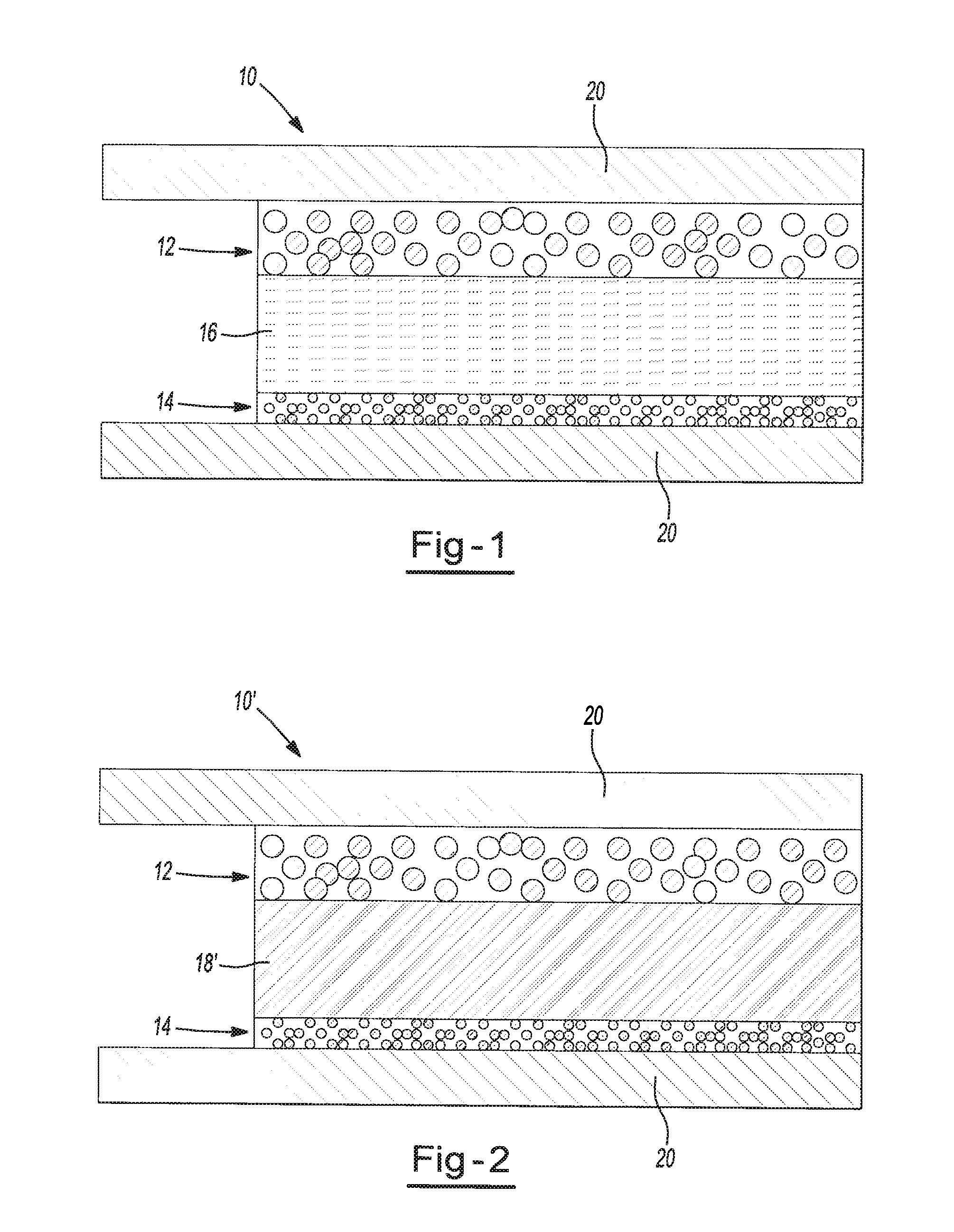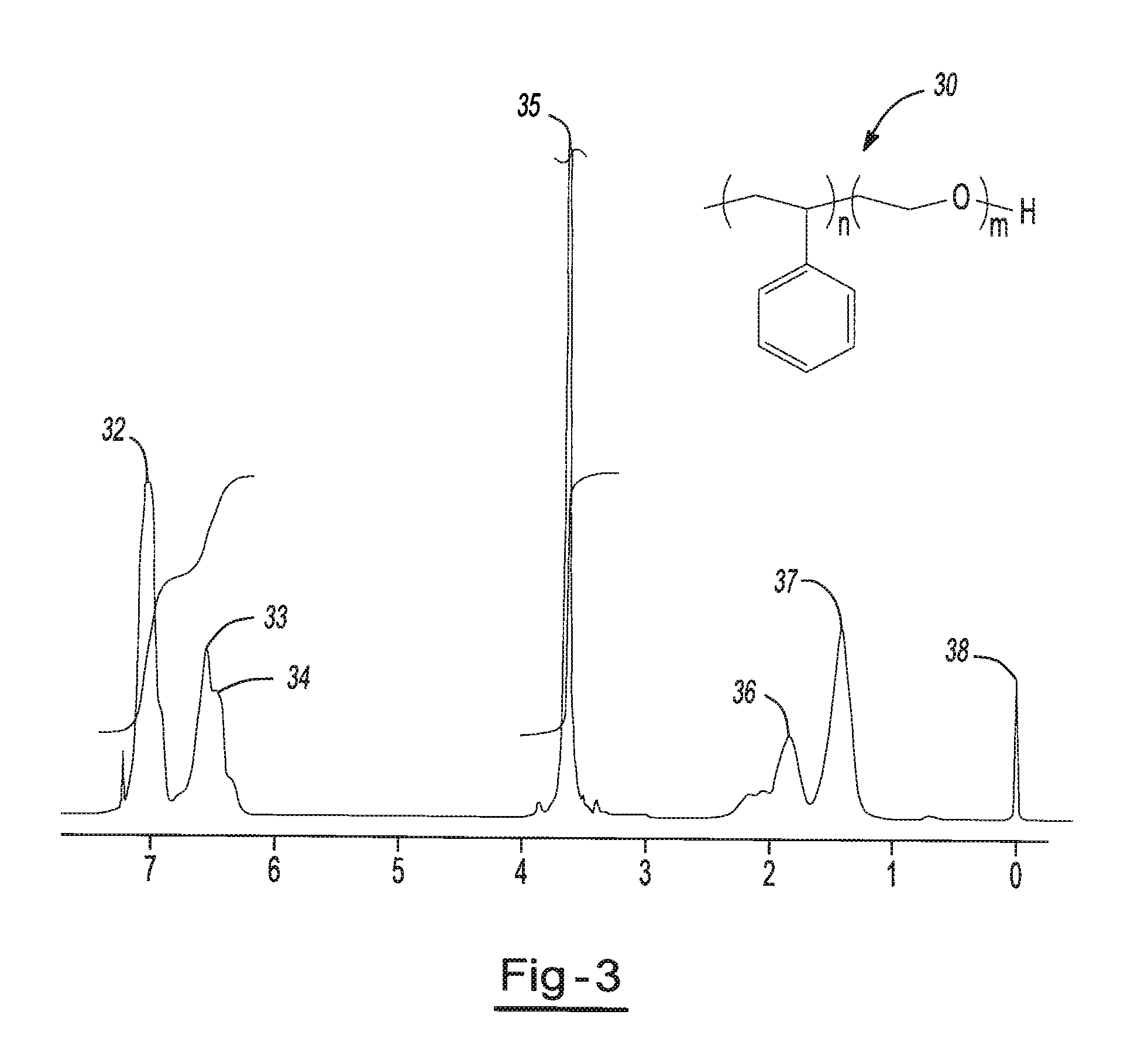Highly conductive polymer electrolytes and secondary batteries including the same
a polymer electrolyte and polymer technology, applied in the field of polymer electrolyte compositions, can solve the problems of difficult to achieve high-performance electrolytes, and insufficient use of single-phase homogeneous materials for battery applications, etc., to achieve high melting temperature or glass transition temperature, high electrical conductivity, and high stiffness
- Summary
- Abstract
- Description
- Claims
- Application Information
AI Technical Summary
Benefits of technology
Problems solved by technology
Method used
Image
Examples
example 1
Polyethylene Oxide Grafted onto an Ethylene-Acrylic Acid Copolymer Using an Ester Linkage
[0096]About 15 mg of an ethylene-acrylic acid (EAA) copolymer having about 6.5 weight percent (about 2.63 mole percent) acrylic acid (commercially available from THE DOW CHEMICAL CO. under the tradename and grade identification of PRIMACOR™ 3340) is dissolved in about 200 ml of hot xylenes at a temperature of about 100° C. About 20.3 g of a poly(ethylene glycol) methyl ether (PEG-ME) having a single hydroxyl group and a number average molecular weight of about 750 (available from Aldrich Chemical) is added to the EAA / xylene solution. The molar ratio of —OH groups on the PEG-ME to the —COOH groups on the EAA is about 2:1. About 1.0 g of p-toluenesulfonic acid (about 5.3 mmol) and about 0.25 g of Irganox® B225 stabilizer is added to the solution. The solution is heated to reflux for about 20 hours. Water is removed from the reaction by azetotropic distillation and collected (e.g., in a Dean-Stark ...
example 2
[0097]Example 2 is prepared similar to Example 1. About 26.1 g of PRIMACOR™ 3340 and 16.5 g of a poly(ethylene glycol) methyl ether having a number average molecular weight of about 350 (available from Aldrich Chemical) is used. The ratio of the OH on the PEG-ME to the COOH groups is about 2.0. The two polymers are reacted in about 300 mL xylene with 1.1 g p-toluenesulfonic acid and 0.25 g Irganox™ B225 stabilizer at time for about 22 hours at a reaction temperature of about 100° C. The product has at least about 80 percent of the acid groups on the backbone converted to ester groups, as determined using infrared spectroscopy. NMR analysis of the dried product indicates that the poly(ethylene oxide) concentration is about 20 weight percent.
example 3
[0098]Example 3 is prepared similar to Example 1. About 26.1 g of PRIMACOR™ 3340 and 35 g of a poly(ethylene-propylene glycol) methyl ether (i.e., a copolymer of ethylene oxide and propylene oxide having a single —OH group) having a number average molecular weight of about 970 (available from Aldrich Chemical) is used. The ratio of the OH on the PEG-ME to the COOH groups is about 2.0. The two polymers are reacted in about 300 mL xylene with 1.4 g p-toluenesulfonic acid and 0.25 g Irganox™ B225 stabilizer at time for about 20 hours at a reaction temperature of about 100° C. The product has at least about 80 percent of the acid groups on the backbone converted to ester groups, as determined using infrared spectroscopy. NMR analysis of the dried product is expected to indicate that the poly(ethylene oxide) concentration of the graft copolymer is about 30 weight percent.
PUM
| Property | Measurement | Unit |
|---|---|---|
| Temperature | aaaaa | aaaaa |
| Temperature | aaaaa | aaaaa |
| Temperature | aaaaa | aaaaa |
Abstract
Description
Claims
Application Information
 Login to View More
Login to View More - R&D
- Intellectual Property
- Life Sciences
- Materials
- Tech Scout
- Unparalleled Data Quality
- Higher Quality Content
- 60% Fewer Hallucinations
Browse by: Latest US Patents, China's latest patents, Technical Efficacy Thesaurus, Application Domain, Technology Topic, Popular Technical Reports.
© 2025 PatSnap. All rights reserved.Legal|Privacy policy|Modern Slavery Act Transparency Statement|Sitemap|About US| Contact US: help@patsnap.com



